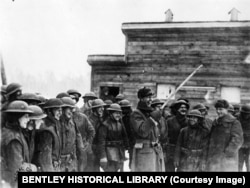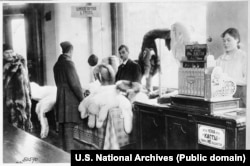These U.S. troops (below) were among some 13,000 Americans sent to Russia's Far North and Eastern Siberia in 1918 to fight both against -- and alongside -- Russians in one of history's strangest conflicts.
U.S. troops (left) parade in front of allied Russian White Army fighters.
A U.S. soldier pauses for a photograph while loading supplies onto a ship bound for Russia in 1918.
After the revolutionist leader Vladimir Lenin and his Bolsheviks seized power in Russia in 1917 with the promise of "Peace, Land, and Bread," the country formally withdrew from World War I. Once Russian guns fell silent, Germany and its allies were able to redeploy hundreds of thousands of soldiers from their Eastern Front and hurl them at the exhausted Allied forces in France and Belgium.
British Prime Minister David Lloyd George expressed fear that the onslaught could mean "disaster" for the Allies. Britain and France began plotting to "reconstitute the fighting front in the East," possibly by linking up with a contingent of battle-hardened Czechoslovak soldiers stranded inside revolutionary Russia, and overturning Russia’s Bolshevik Revolution by force.
Meanwhile, military supplies worth millions of dollars that the United States had shipped into Russia lay unused and at risk of being captured by German forces.
U.S. President Woodrow Wilson, under pressure from Britain and France, agreed to send U.S. troops as part of an expeditionary force to Russia in the summer of 1918. He said he was "sweating blood" over the decision.
U.S. soldiers land in Russia's Arkhangelsk in September 1918. Their ship was painted in "dazzle camouflage" designed to make it hard for enemy submarine crews to estimate the ship's direction and speed.
Wilson's stated aim for the U.S. troops was to guard supplies and assist the stranded Czechoslovak forces, who were increasingly in danger as the civil war raged across the country following the Russian revolution. Wilson apparently opposed further military intervention, believing U.S. entanglement in the conflict would only "add to the present sad confusion in Russia rather than cure it."
An allied military camp, with Murmansk harbor in background.
U.S. soldiers shop in a Russian market.
Most of the troops sent to northern Russia were from Michigan. The U.S. military command thought Michiganders would be better able to cope with Russia's brutal winter weather than troops from warmer states.
A U.S. soldier scans the Russian forest for Bolshevik fighters.
Wilson was reluctant to wade into a civil war between the Bolshevik militia and Russia's White Army -- a motley grouping of fighters opposed to Lenin's revolution. Nevertheless, U.S. troops were almost immediately thrust into battle by the British officers who commanded them.
A Bolshevik shot dead after attempting a late-night raid on a U.S. outpost in Russia's Far North.
Much of the materiel the U.S. soldiers were sent to guard had already been looted before they arrived in Russia. This slain Bolshevik fighter was equipped with a modern U.S. Remington rifle and "plentiful" ammunition.
The flag-draped coffin of a U.S. soldier being lowered into the soil of Russia's Far North.
Americans in snow camouflage, which one soldier described as recalling "to my mind accounts of the Ku Klux Klan."
A U.S. captain raises a sword captured from a Bolshevik fighter.
A young Bolshevik fighter who was killed while attempting to flank U.S. positions in Russia's Far North.
U.S. soldiers and their allies in northern Russia, November 1918.
The Americans fought under British command as part of a multinational expeditionary force.
French troops were sent to Russia after years of combat in the trenches of the Western Front during World War I.
French fighters at a machine-gun nest.
One U.S. soldier recalled, "it is a comfortable feeling to look out and see these cool Verdun veterans."
One American was less enthusiastic about his Canadian comrades in arms (pictured) and recalled that after a battle some had passed among the Bolshevik dead "like ghoulish things, stripping bodies of everything valuable...with astounding glee, like schoolboys on a hilarious holiday.... They were generous-hearted, hardy, whole-souled murderers."
Captured Bolsheviks.
Some communist fighters carried out savage revenge on captured Americans. One U.S. soldier who barely escaped alive after a forest battle reported that the Bolsheviks were castrating the wounded. The body of one U.S. soldier who killed himself with his revolver before the Bolsheviks reached him was later unearthed "hacked almost beyond recognition."
The U.S. contingent also fought alongside Russians who opposed the Bolsheviks, like this gun crew that was part of the so-called White movement.
A U.S. soldier looks across to the Bolshevik-held village of Shenkursk in the distance. The Americans' position was captured by the Bolsheviks two weeks after this photo was taken.
A U.S. outpost in the wilderness of Russia's Far North.
In November 1918, U.S. forces who'd been fired upon from the village of Upper Tulgas drove the villagers out of the settlement and burned it to the ground. A sergeant later wrote, "My heart ached to have the women fall down and kiss my hand and beg me not to do it...but orders is orders."
Bolshevik prisoners are fed rice by a U.S. soldier in January 1919.
A Russian peasant "exhausted from starvation" rests on the steps of the U.S. headquarters in Arkhangelsk.
A Russian man at a market in Russia's Far North.
One U.S. soldier described the locals he met as "quite hospitable and very honest -- no petty thieving is done, but they would sell their soul for a drink of rum."
Locals line up for food aid from the American Red Cross in Arkhangelsk.
A shop that sold furs in Arkhangelsk was popular among Allied troops.
Americans in a reindeer "taxi" -- a common form of transport.
U.S. military engineers at a field camp in Russia.
By 1919, World War I was over and the Bolshevik Red Army was becoming an increasingly formidable fighting force.
Fresh American graves in Russia.
In 1919, a U.S. commander said to his superiors: "The morale of any force depends a great deal on the rank and file knowing for what they are fighting...the men have gone through hardships and fighting cheerfully, but will soon begin to say among themselves, 'Why are we here?' It is my business to answer that question, and I cannot."
Officers of the Allied Expeditionary Force in Arkhangelsk in 1919.
As the tide turned in the civil war, the Red Army's command was determined to drive foreign troops out of Russia -- accelerating a Bolshevik campaign of terror as they advanced.
A grain store set ablaze by Bolshevik fighters.
U.S. troops retreated to this settlement north of Arkhangelsk in June 1919 to await evacuation.
After months of a nightmarish existence in the Russian wilderness, one U.S. soldier arriving at the settlement was stunned to see "civilized girls for the first time" with "regular dresses and silk stockings."
A farewell dance for U.S. troops in Arkhangelsk.
One U.S. soldier remarked about the Russian girls: "They dance the same as we do at home," but they "refused flatly to dance with men who were drunk."
Russian "war brides" who would soon leave their homeland for a new life in the United States with their soldier husbands.
U.S. soldiers await the ships that would carry them home in the summer of 1919.
Some historians think Lenin held back from a final, bloody assault on the Allies because of the damage it would do to the reputation of Russia's new government, which was then hoping to win international recognition.
U.S. troops line up for inspection before leaving Russia in June 1919.
By September 1919, all Americans had left the port. The Arctic campaign had cost the lives of between 210 and 244 U.S. soldiers, many to disease and accidents.
U.S. Troops marching in Khabarovsk.
The mission for the U.S. contingent sent to Russia's Far East -- partly to guard supplies and protect the Trans-Siberian Railway -- had been even more vague and shifting than their compatriots in the Far North. They were pulled out of Russia by April 1920. Nearly 200 Americans died during the Siberian expedition.
A lieutenant wrote: "When the last battalion set sail from Arkhangelsk, not a soldier knew, no, not even vaguely, why he had fought or why he was going now, and why his comrades were left behind -- so many of them beneath the wooden crosses."




































